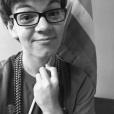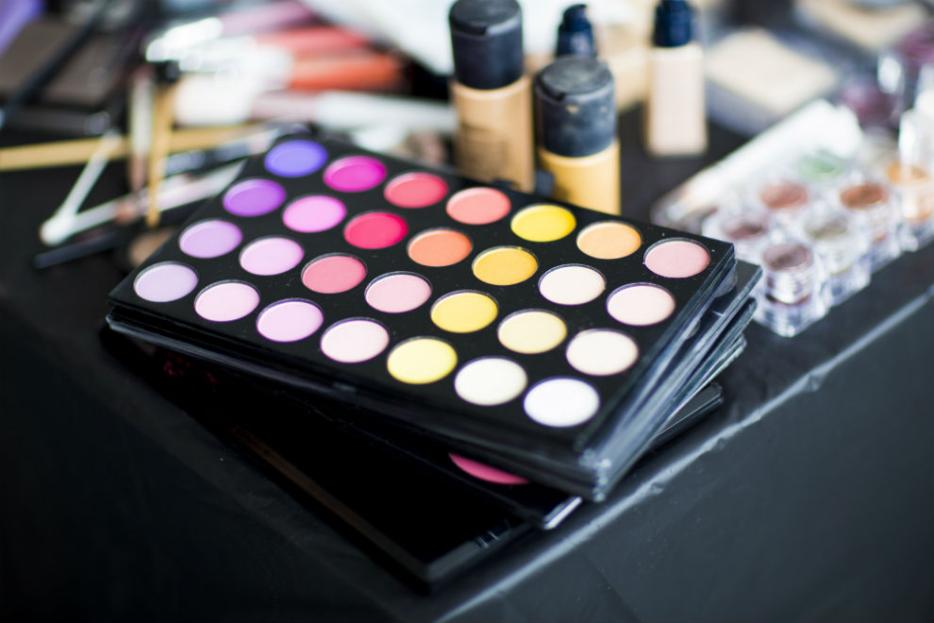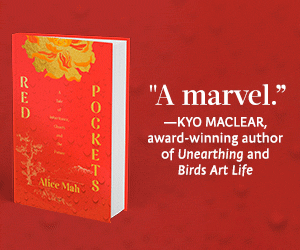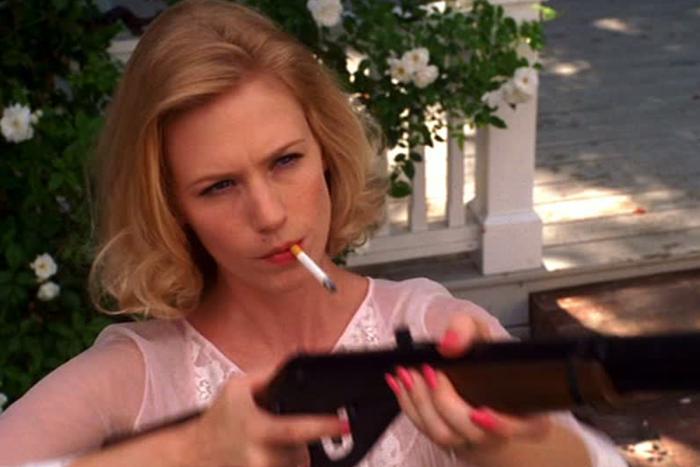The first makeup I ever wore was pixelated. The lipstick: two bands of fuchsia. The mascara: a thicket of lashes styled thin and charcoal black. The eyes: bejeweled, with patterned purple and gold gemstones stretching from the bottom of my nose to the top of my eyebrows. All of it, pixels.
I used my first Snapchat makeup filter in secret, on the bottom floor of my high school library, behind a bookshelf where I knew no one would see. But even the isolation couldn’t stave off my fear. As I swiped through the various filters—the dog ears, the rainbow mouth—to the bejeweled makeup I'd seen a friend use earlier that day, I felt something building inside of me, something that turned my stomach. In my head I was already writing my apology—I’m sorry, it was a mistake, it won’t happen again. Sitting there, in the hush of the library, I felt delinquent—that by trying on even virtual lipstick I was breaking some sacred covenant I’d made with society, one premised on conformity.
The fear existed for the same reasons it always had: because I’d been taught to hate men with makeup, because I didn’t want to make myself a target, and, most fundamentally, because I knew I couldn’t have it both ways—I couldn’t explore myself and remain a model queer boy, a boy who fits in. But this time, there was also something new, a feeling so small I almost didn’t notice it—a glimmer of excitement.
I took a breath before I tapped the bejeweled makeup filter, and then I watched as it spread across my face: the mascara, the lipstick—emblems of femininity that I was finally letting myself claim.
If this were a movie, here I would zoom in on my features, fear giving way to glee as I realized that I liked this makeup. I liked how it looked. I liked how it felt.
Now, rewind one year, two, ten, twelve—past the day the word “faggot” first made my skin scrawl, past the crushes on other boys I convinced myself were platonic, past the fear of fashion-forward clothing and high-pitched voices. Rewind until I am a boy sneaking into my mom’s clothes closet while she’s on the phone downstairs, running my fingers along her dresses and shoes, then opening up her makeup cabinet and staring at it all—the balms, the blushes, the powders, the highlights. Rewind until I am looking at my face in the mirror, longing to put on just a dash of lipstick, but somehow already knowing I shouldn’t.
Freeze the image there. Go split screen: to the left, myself as a six year old imagining how wearing lipstick would look; beside it, me twelve years later, using that Snapchat makeup filter for the first time. Then, slowly, let the faces converge: bright eyes on tired ones; clear skin on slight stubble; hope on wonder.
*
Where I grew up, feminine boys were cautionary tales. I remember in elementary school you couldn’t wear a bright pink or purple shirt without sustaining a barrage of slurs, whispered between breathless laughter. Even before I understood what words like “fag” meant, I was taught that the people they described were two things: men who were feminine, and therefore men who were repulsive.
TV, which as a kid I took as a universal truth, pushed this thesis further. There, feminine men existed to shock. On crime shows, they were presented alongside drug dealers and fetishists, agents of a strange, perverted underbelly. On sitcoms, they were joke fodder. Feminine males existed, in other words, as the antithesis to normal—as viewers, we could feel more secure in who we were because at least, we told ourselves, we weren’t like that.
In movies, too: think of Billy Madison’s lipstick-wearing Danny McGrath, who makes lists of people he intends to kill; or Edward II from Braveheart, whose ineffectiveness is tied to his effeminacy.
The trope of male femininity as a proxy for weakness and psychopathy extends to stories as classic as Little Red Riding Hood, where the wolf’s awfulness is heightened by the fact that he wears women’s clothing, and continues through classic films such as Psycho and The Silence of the Lambs, whose depictions of crossdressing serial killers have fed into homo- and especially transphobia.
This creates a special peril for queer men, because, according to a mid-20th century study by Daniel Levinson, a primary driver of male-centered homophobia is the equation of homosexuality with emasculation. As Paula S. Rothenberg notes in her book Race, Class, and Gender in the United States, “gay men have historically played the role of the consummate sissy in the American popular mind because homosexuality is seen as an inversion of normal gender development.” Belief in such an inversion has led to the repeated depiction of feminine men as unhinged. They are weak or violent or disgusting, we can say, because they aren’t sufficiently masculine.
Though this idea impacted all queer men, feminine men were most easily targeted because they either lacked or had forfeited their ability to pass for straight. In pop culture, they became easy villains.
In his 1968 memoir, The Naked Civil Servant, Quentin Crisp describes how the fear of male femininity manifested itself in law enforcement, claiming that the police targeted feminine men. “Boys arrested for soliciting were found guilty before they had spoken,” he says. “If they did get a chance to say anything, the sound of their voices only caused the presiding magistrate to increase their sentences. I think the boys were right in assuming that they were being condemned for effeminacy.”
The trope of the deplorable feminine male became so damaging that when gay activists began their efforts to assimilate into mainstream society, they specifically distanced themselves from it. It is no coincidence that in 1973, at the same time LGB people began attaining successes, such as the declassification of homosexuality as a mental disorder, fashion among queer men shifted from a “fairy” look to a more masculine aesthetic centered on tight jeans, plaid shirts, and facial hair. In her book Transgender History, Susan Stryker argues that “it is possible to trace the current ‘homonormativity’ of mainstream gay culture (an emphasis on being ‘straight-looking and straight-acting’)”—in other words, on masculinity—to this period.
Around the same time, LGB groups distanced themselves from the transgender community, which was deemed unpalatable to the general public, even though trans women of color, such as Marsha P. Johnson and Sylvia Rivera, initially sparked the gay liberation movement. After flirtations with radicalism following the Stonewall Riots, many gay and bisexual men decided that to be accepted, they had to look and act agreeable—and that meant an embrace of masculinity.
Certainly, this didn’t ensure their safety—no queer person is ever truly safe—but then, as now, perceived masculinity offered queer men a refuge from the worst abuse; feminine men, who can’t “pass,” have always posed a threat in a way their masculine counterparts have not. Which is why the prospect of wearing makeup has long terrified me.
As a gay kid who was born mere months after DOMA became law, and who turned eighteen the same year the Supreme Court affirmed the right to marry, I have seen how quickly homophobia erodes. In my small Connecticut town, my childhood spent learning to hate people like me melted into an adolescence in which I came out to relative ambivalence. But that newfound acceptance is conditional—my existence is validated only when I act like, talk like, dress like everyone else. Being queer is different than being queer and gender subversive. The former we’ll allow as long as you don’t flaunt it: don’t talk about your desires, don’t hold your partner’s hand in public, don’t dress like the opposite gender. The latter is disgusting, despicable—a threat.
When Instagrammer Skelotim gained popularity for matching his makeup to popular snack food wrappers, the social media site started taking down his photos because they’d been repeatedly flagged. Many people were offended to see a man in colourful makeup. And last year, when a BuzzFeed writer decided to try on makeup for a week, he noticed that many men ignored him. “I’m used to walking around making eye contact, nodding, smiling, and receiving eye contact, nods, and smiles in return. But every man at work who I don’t know (it’s a big office) looks anywhere but at my face,” he wrote. Later, at a turnstile, a man bumped into him and said, “Watch it, faggot.”
Even early this year, after Maybelline announced that popular Instagrammer Manny Gutierrez would become their first male spokesperson, the move was decried as a “symptom of a decaying culture.”
*
There is a public performance to queerness that is often neglected. Since before middle school, I learned that to be safe, I needed to excise any femininity in myself—to moderate my hand gestures, to wear plain clothes, to lower my voice when I talked. (The possibility that I might be able to render myself invisible is a privilege that many transgender people and queer people of color are not afforded.)
And this, I realize, is roughly what activists did in the 1970s, and what media coverage of the LGBT community continues to do today, which is to present only the manifestations of queerness we deem most acceptable. Notice how ads that include LGBT people invariably feature well-dressed (and overwhelmingly white) couples with typical gender presentations, or how popular slogans like “love is love” and “same love” work because they emphasize our uniformity with the rest of the society. Similarly, coverage of trans people, actress Laverne Cox has noted, centers on “cisnormative beauty standards” attained only “in certain lighting, at certain angles.”
It is acceptance by conformity, and as a result living publicly as a queer person can become a constant negotiation: Is this pushing it? The fact that I’m non-binary isn’t impacting my friendships, but what if I start wearing a completely new style of clothing? People won’t mind me going to the movies with my girlfriend, but is it too much if we hold hands? Or, in my case: my parents accept my sexuality, but will I shock them if I walk out of my bedroom one day clad in fuchsia lipstick and green eyeshadow?
We love to teach kids the importance of self-exploration, but there’s an unspoken limit: once you drift beyond the predetermined, “acceptable” zone of inward scrutiny, what first made you charming—your brazen individualism, your eagerness to explore—instead perverts you into a danger. Part of growing up queer, I think, is the repeated confrontation with these limits. As a kid, you are taught homo- and transphobia as a baseline, and coming out therefore becomes more than just a process of disclosing your sexuality or gender. It is also the process of unraveling your internalized prejudices, of giving yourself permission to do all of the little things you grew up avoiding—in my case, things like buying my first purple shirt and letting myself speak in my normal, slightly high-pitched voice. But I’ve always known not to go too far. I’ve always known the limits. For me, that has primarily meant one thing—no makeup.
In our society, queerness is a burden: one that many people are now willing to take, but barely. Add on any more weight—be a queer man with makeup, a queer woman in a tie—and it all comes crashing down.
*
My attraction to makeup returned because of a boy.
In this case, the boy is a popular Instagrammer, no one I’ve met in my real life, and he wears magenta lipstick and gorgeous green eyeshadow. He’s attractive, I’m not going to lie. But he also seems so free: so brazen, so brave, so unashamedly him. I forgot, I realized, how good makeup could look on a boy. More: I forgot how happy a boy could be with makeup on. I’ve been so conditioned to associate male femininity with ugliness that I didn’t think it could be anything else.
Soon after, I remembered the way I used to envision makeup when I was younger: as a kind of social art, a bridge between your inner and outer selves; as a type of decoration that enlivens your appearance, adds some flair to an otherwise empty face.
I remembered this, and at the close of my senior year of high school, I watched my desire to try on makeup grow. No longer just trivial, it tugged at me. Just wear a little lipstick to prom, it said. A little blush to graduation. Just to see how it looks.
I started dropping hints to friends, too. “When we’re out of college and move in together, you should teach me to do makeup.” Or: “Before the end of the year, I’m going to wear eyeshadow to a party.” It was a quiet longing, and there was comfort in indulging it: setting vague goals for myself, imagining a day when I could leave my room clad in brightly coloured makeup.
But I was still afraid. In the barter economy of public queerness, it felt like a weight too heavy for most people to accept.
So, I turned to Snapchat.
*
For those unfamiliar, Snapchat traffics in ephemera. Photos dissolve seconds after they are opened; conversations on the app take on a detached quality. No one remembers what was said, or what pose was struck, three, four selfies back. When you receive a new photo, it is like the conversation is beginning all over again.
It also boasts a vast catalogue of filters—digital decorations for your face—and it is these I have begun to use and send religiously. Many are for comedy: a cyclops, a pacifier, a unicorn, a viking. Filters that distort your face: double the size of your eyes or nose, curl up your lips, bloat your chin. In a way, that kind of self-parody is cathartic, and it lets us disentangle ourselves from the perfectionism of social media. Instead of posting only the most glamorous photos of ourselves, as on Instagram, on Snapchat we can revel in our imperfections.
Many of Snapchat’s filters are also makeup-related, and these introduced me to a kind of makeup-wearing intermediary: on the app, I could try on makeup without the full risk of wearing it in public.
I have used Snapchat’s digital makeup filters often. Red and black and pink lipsticks; mascara and eyeliner and coloured eye shadow. Selfies at different angles, different poses. Over the last half year, I have taken these pictures and sent them to friends with increasingly little shame, and I like how their compliments feel.
One friend replied, “You need to wear this to school!” When I opened that message, I grinned. Already I felt my fears of makeup unraveling.
Snapchat is safe, I think, precisely because it is transient: I can try on new looks and get reactions from friends, only to have it all evaporate, half-forgotten, within a few minutes. For all my friends know, my use of makeup filters constitutes just another example of self-parody, like those unicorn filters I love so much. There is no public risk, no reason to fear: it was the best way—and, for me, perhaps the only way—to ease into a new look I had once been taught to hate. These filters became a kind of premature introduction, a way of telling my friends, Next time you see me, this is how I might look. The stakes were low, and low stakes were freeing.
*
Historically, this is not new. Queer people have long carved out semi-anonymous spaces to explore themselves, their genders, and their sexualities in times of hostility. In 18th century England, queer people escaped to covert social gatherings known as molly-houses, where they often took on attributes typically ascribed to another gender. Men wore gowns, petticoats, high-heeled shoes, and masks; some painted their faces, and others tried on rouge and eye makeup. Their lives took on a duality and their safety depended on balancing self-exploration in the molly-houses with uniformity in the outside world. Those who slipped up—those who accidentally dressed or spoke with too much femininity in their day-to-day lives—were, according to one historian, “abused or blackmailed.”
A similar phenomenon has followed the rise of drag kings and queens, whose use of makeup and atypical clothing allow them to explore the boundaries of who they are from places of relative safety. And perhaps it is here that makeup has taken on its special significance for queer people. Makeup became part of a larger concert of liberation, a challenge to social norms policing dress and voice and gender and love. As Arabelle Sicardi writes, “This processing of potential, pushing past the point of expectation of who you have to be for other people to reach who you want to be for yourself — that’s beauty, gone queer. Because queerness is sexuality, yes, but it’s also an identity that implies resistance and reaching for something else.”
For queer people, makeup is a language of resistance. We are told again and again that the way we use makeup is wrong: that it is disgusting, unsuitable; that it is reflective of the ugliness inside of us.
For men, wearing makeup—or any emblem of femininity—has historical associations with depravity, and putting it on is therefore as dangerous as it is freeing. Such an embrace of the self in a society that demands uniformity is a powerful act, precisely because it forfeits any passing privilege that comes with an invisible identity. From the first dash of fuchsia lipstick, you are on display.
I was well aware of this when, on a Friday night in September, I borrowed a friend’s lipstick and mascara and wore makeup to a party for the first time. I did it because I felt safe: it was dark, and few people could see, and now that I live on a liberal college campus, I worry less when people discover I am a queer boy with an interest in femininity. And I liked it. It felt odd, this extra weight on my skin and eyelashes, but in the best, most thrilling way.
Over the last few months, I’ve repeated this process. On multiple occasions I’ve worn makeup to late-night parties, more self-conscious about the fact that it was sloppily applied than about the makeup itself. I’ve started watching makeup tutorials on YouTube, too. And through those, I’ve found a subculture of makeup-wearing queer boys, from Patrick Starrr to James Charles, who recently became the first CoverBoy. Now my college dorm room is home to an assortment of eyeliners, lipsticks, mascaras, and eye shadows.
But the fear hasn’t left, not really. In October, when I wore purple nail polish for a day, I felt the stares. Many people, it turns out, were encouraging, but the idea of being watched unsettled me. I took the nail polish off that night, after a driver who was stopped at an intersection called me a slur.
When I wear makeup, my passing privilege evaporates. I become the kind of queer boy long scapegoated in books, TV shows, and movies—the feminine male who refuses to conform.






